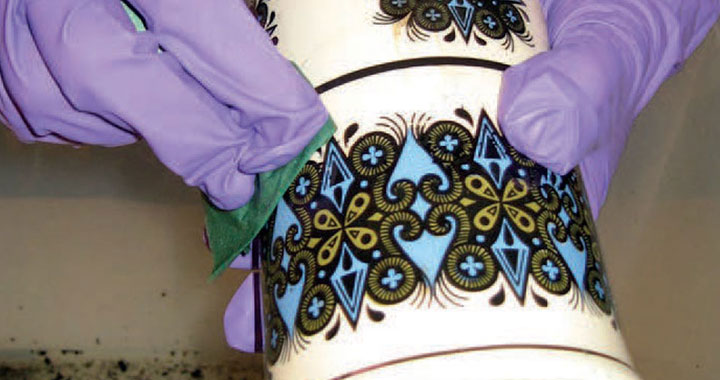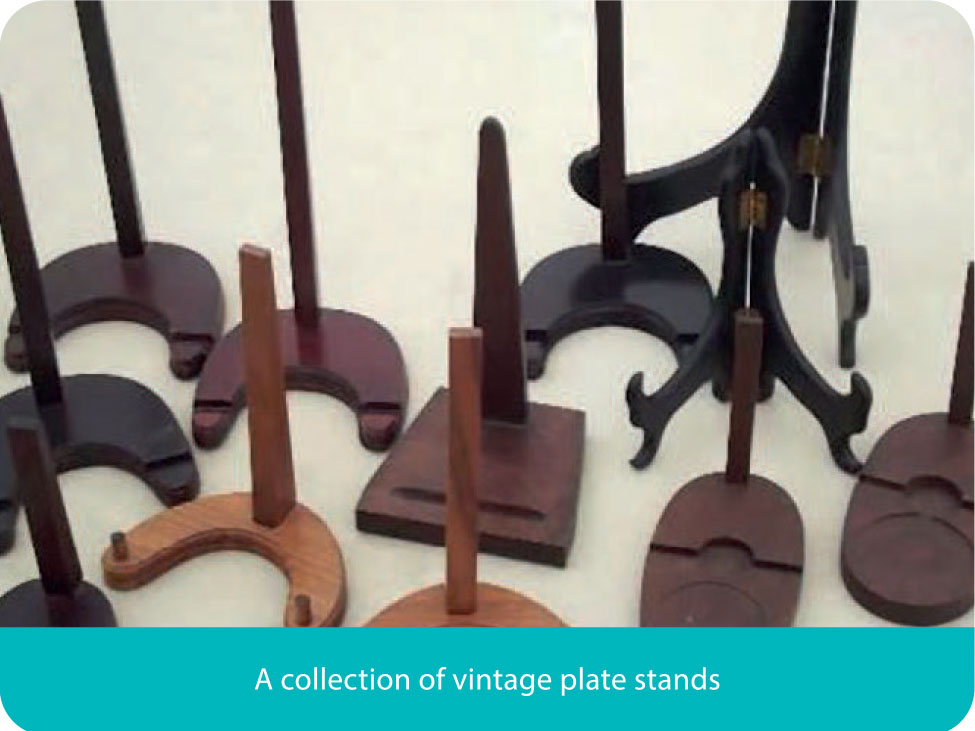Dame Magdalene Odundo (Kenyan/ British, b. 1950) is arguably one of the most important artists working in Britain today and the definitive contemporary ceramicist of the modern era.
Odundo’s oeuvre typically consist of sculpture in clay and on occasion in glass. These forms simultaneously traditional and modern – equally unpretentious and layered with meaning. Her work is almost timeless – galleries exhibiting her pieces often choosing to display them alongside historical artifacts and objects from societies which she has taken inspiration from.
The creation of her work is a complicated process. The sculptural vessels are predominantly hand-built coiled pots, formed in terracotta, using a traditional technique learned in Nigeria. They are typically decorated in slip, multi-fired and polished. Her work is recognisable by the strength of the form and glazes – usually either almost metallic in burnished brown/ black or orange/ red oxide.

Odundo, has discussed the closeness the shapes of her work take to the human form – and that naming terms for pottery vessels such as ‘neck’ and ‘body’ make pots anthropomorphic – vessels have the exterior on show, whilst the interior is hidden, as individuals do.
In recent years Odundo’s status has been reflected by a significant number of dedicated exhibitions of her work. These exhibitions have included Magdalene Odundo: The Journey of Things held at The Hepworth Wakefield (February 2019 – June 2019) and Sainsbury Centre (August 2019 – December 2019); Magdalene Odundo in Cambridge at the Fitzwilliam Museum (December 2021 – June 2022); Magdalene Odundo: A Dialogue with Objects held at the Gardiner Museum, Canada (October 2023 – April 2024) and the exhibition currently being held at Houghton Hall, Norfolk (* until 29th September 2024).

Dame Magdalene Anyango Odundo was born in Nairobi in 1950 and spent her childhood in India, Nairobi, and Mombasa. She was primarily educated in Kenya by Irish nuns – and according to the artist had little knowledge of ceramics. The colonial education system invariably overlooking the chiefly female tradition of making pots for food preparation.
She initially trained in Kenya as a Commercial and Graphic Artist. She travelled to the UK in 1971 to continue her studies – she has lived and worked in England since this time.
Between 1971 – 1973 Odundo was a student at Cambridge College of Art. It was here she first discovered her passion for ceramics. As she revealed in a 2021 interview
“The first time I actually encountered clay I just literally fell in love with it”.
Magdalene Odundo has discussed the importance of clay to her work, considering the connection between pottery and the earth – to quote “you come from it, and you go back to it”. She has referenced how ceramics have been used to produce vessels throughout human history and across civilisations. The corelation between the shapes she creates – the human form and therefore condition – are also pivotal.

She achieved a BA in Ceramics at West Surrey College of Art and Design (renamed University of Creative Arts) between 1973 – 6. Odundo became a University Professor at this institution in 2001 and Emirta Professor in 2016 and Chancellor of the institution. Magdalene Odundo is closely linked with Surrey and is based in Farnham.
During the early part of her career, Odundo, visited Kenya, Nigeria, and the Pueblo people in New Mexico to learn pottery building and glazing techniques. In 1976 The Hepworth Wakefield made the first acquisition on of her work by a UK institution – ‘Eniasulo (Water Carrier)’ (1974-6). She was awarded a Masters in Ceramics from the Royal College of Art in 1982. It was after her exhibition in the early 1980s that appreciation of her work became more widespread.
The Magdalene Odundo exhibition currently being displayed at Houghton Hall, Norfolk brings together several of Odundo’s important works in both ceramics and more unusually glass. The show is the first at Houghton dedicated to the work of a female artist and additionally a black artist. The exhibition aims to create a juxtaposition and a dialogue between the opulent interiors of the Palladian house and Odundo’s contemporary sculptures.

One of the most impactful pieces is a new work displayed as a dining table centrepiece in Houghton Hall’s Marble Parlour. The work was produced during Dame Odundo’s yearlong residency at Wedgwood, Stoke on Trent. The piece reflects upon Wedgwood founder Josiah Wedgwood’s campaigning for the abolition of slavery and work as a ceramicist. This large multi-tiered sculpture is atypical of Magdalene Odundo’s work.
To quote the artist
“It is the first time I’ve used narrative and figure and ornament in my work, because my own work is very paired down, very plain. The discovery of all the ornaments and the figures within the Wedgwood tradition gave me a platform to use narrative and storytelling”.

Odundo uses Jasperware – instantly recognisable as Wedgwood in Black and Cane colours, first used in the 1770s. The lower two-tiers feature horrifying symbols of slavery, and figures, akin to of those depicted in the shocking 18th century Brook’s slave ship illustration. The upper tier has images of recent protest in Nairobi. Odundo was able to refer to the design in the Wedgwood archive, including the anti-slavery medallions.
For the Houghton Hall exhibition, her modern objects are placed in contrast with the antique and historic pieces, within interiors designed by William Kent for Robert Walpole.

In the Green Velvet Bedchamber where typically a pair of Chinese porcelain cranes are on display – one has been replaced by Magdalene Odundo’s ‘Untitled’ (1995) – these two ceramic pieces seem to be in a direct dialogue with one another. The shape of Odundo’s vessel and black glaze complimented by the chinoiserie cabinet it sits upon.

In the Stone Hall seven objects are on display – five in the centre of the room raised on plinths – and a pair in orange glaze set within alcoves. Against the bright white stone, the black and orange glazed sculptures are shown to their best advantage.
The Magdalene Odundo exhibition is currently being held in parallel with one-hundred Anthony Gormley iron sculptures – installed around the estate.

The market for Dame Magdalene Odundo’s work has been very buoyant this century. In recent years demand and prices have increased dramatically.
To illustrate, it is worth looking at pieces which have appeared on the open market historically and have been offered again this decade. In September 2006 Bonhams London offered ‘A rare Vase Form’ executed by Odundo in 1986. (Lot 220, Bonhams, International Contemporary Ceramics, 19th September 2006) At that time the piece sold for £27,600 (including BP).
The same work described as ‘Untitled’ was offered in June 2021 at Sotheby’s London (Lot 32, British Art Evening Sale Modern/ Contemporary, 29th June 2021). This time the vessel sold for £378,000.
Notably, ‘Untitled’ (1984) was sold by Sotheby’s in June 2022. (Lot 2, British Art: The Jubilee Auction, Sotheby’s London, 29th June 2022). When first going under the hammer 15 years earlier at Bonhams NY the lot had been titled ‘Mixed Colour Flat-Topped Winged’ – achieving $45,000 (Lot 90, International Post-War and Contemporary Ceramic Art, Bonhams NY, 5th June 2007). In 2022 this work sold for a second time reaching £302,400!
In July 2021 Somerset auctioneers Lawrences of Crewkerne sold a ‘Terracotta Vessel’ produced by Magdalene Odundo in 1985. The work sold for a hammer price of £94,000 (Lot 27, 19th/ 20th Century Design, Ceramics…, Lawrences of Crewkerne, 19th July 2021). The same piece appeared at Sotheby’s less than three years later in June 2024. This time reaching a total of £240,000!
Over the past 18 months records for the artist work have been broken. In June 2023 Sotheby’s sold one of the most striking of her vessels ever offered at auction – Dame Magdalene Odundo’s ‘Untitled’ (1999). Against an estimate of £100,000 – 150,000, it reached £533,400.
For those wishing to view her work in person, it can be found in the collections of the Metropolitan Museum of Art in NY, Pallant House Gallery in Chichester and The British Museum, London.
The ‘Magdalene Odundo’ exhibition continues at Houghton Hall until late September. A solo exhibition of her work will open at the Thomas Dane Gallery, London on 9th October 2024 and displayed until 14th December 2024.






















